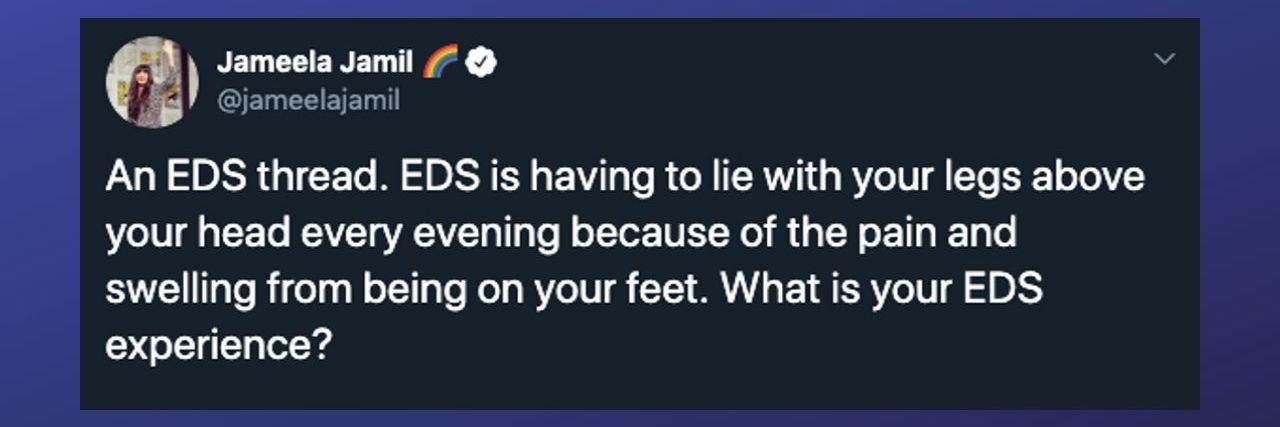When you live with Ehlers-Danlos syndrome (EDS), what may seem like a simple, everyday activity to most people can cause a range of issues, from dislocated or popping joints to the exhaustion of doing ordinary things like going for a walk, rolling over in bed or pushing a grocery cart. “The Good Place” actress Jameela Jamil, who revealed in March she has hypermobile EDS, took to Twitter Thursday to share one way she copes and invited other zebras to do the same.
• What is Ehlers-Danlos Syndrome?
• What Are Common Ehlers-Danlos Syndrome Symptoms?
EDS is a genetic disorder that impacts the strength and amount of connective tissue in your body. EDS can affect anywhere in your body, commonly in your joints, skin or organs, which leads to Ehlers-Danlos symptoms such as full or partial joint dislocations, fragile skin, easy bruising, chronic pain, fatigue and digestive issues.
Jamil shared a photo of her socked feet up in the air to demonstrate how she copes with pain and swelling in her joints at the end of the day. After sharing her nighttime EDS coping skill, she invited others to chime in with their own experiences with EDS.
“An EDS thread. EDS is having to lie with your legs above your head every evening because of the pain and swelling from being on your feet,” the actress tweeted. “What is your EDS experience?”
This #edsawareness thread is blowing my mind. You’re all such legends, coping with this daily. ???????? https://t.co/WFpP8i8Qjy
— Jameela Jamil ???? (@jameelajamil) September 26, 2019
Jamil’s fans rose to the occasion and shared other ways their lives are affected by EDS symptoms, related conditions like postural orthostatic tachycardia syndrome (POTS), the challenge of getting an EDS diagnosis, living with an invisible illness, and even perspectives from caregivers.
“EDS is lots of bruising for no reason, subluxing fingers while taking notes in class, echocardiograms and pain management,” wrote Twitter user @AwkwardKelley. “EDS is pain meds and nausea and tight muscles and fatigue and fainting and ER visits. EDS is explaining to everyone in your life what EDS is.”
EDS is lots of bruising for no reason, subluxing fingers while taking notes in class, echocardiograms and pain management. EDS is pain meds and nausea and tight muscles and fatigue and fainting and ER visits. EDS is explaining to everyone in your life what EDS is. pic.twitter.com/i9xB4AwLuC
— bridget? (@AwkwardKelley) September 26, 2019
Waking up and making sure everything is in its rightful place.
— N (@nikkilynne4614) September 26, 2019
#EhlersDanlosSyndrome is having to wear painful, chafing, sweaty, knee-back-elbow YOU NAME IT braces. All very carefully hidden under your clothing, but necessary to in keep your ribs, knees, and elbows from dislocating and wrecking havoc on your body. ???? pic.twitter.com/HW2yuth3CG
— Simon and Martina (@eatyourkimchi) September 26, 2019
Hill–Sachs fracture as a result of repeatedly dislocating my shoulder without realising while hanging the laundry
— Asher Wolf (@Asher_Wolf) September 26, 2019
it’s getting accused of “faking it” to get out of doing things. EDS is waiting game, to see what will hurt or what joint will subluxate or dislocate next. :/ sucks that u have to go through that, i wish people would become better educated on invisible illness and be kinder
— anne (@annesedgley_) September 26, 2019
My EDS experience is being the husband and father of two with hEDS and fighting hard to help others with Ehlers Danlos. My feed is entirely dedicated to info about EDS. also wrote two articles on being a EDS caregiver. So it’s my life in many ways.
— Bob Simonoff (@SimonoffBob) September 26, 2019
If you’re living with EDS, know you’re not alone. There are many other warriors out there who know exactly what you are going through. To learn more about EDS and get support, check out The Mighty’s Guide to Ehlers-Danlos syndrome, including EDS symptoms, how to get an EDS diagnosis, treatment options and resources.
Header image via Jameela Jamil’s Twitter

